一般现在时第三人称单数形式用法+练习
动词第三人称单数练习题
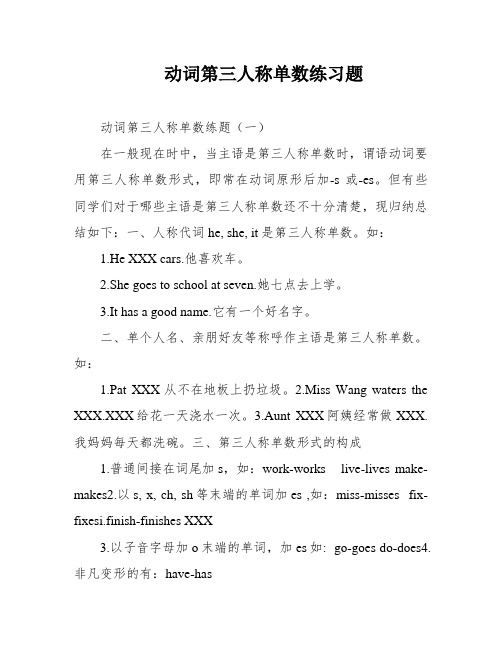
动词第三人称单数练习题动词第三人称单数练题(一)在一般现在时中,当主语是第三人称单数时,谓语动词要用第三人称单数形式,即常在动词原形后加-s或-es。
但有些同学们对于哪些主语是第三人称单数还不十分清楚,现归纳总结如下:一、人称代词he, she, it是第三人称单数。
如:1.He XXX cars.他喜欢车。
2.She goes to school at seven.她七点去上学。
3.It has a good name.它有一个好名字。
二、单个人名、亲朋好友等称呼作主语是第三人称单数。
如:1.Pat XXX从不在地板上扔垃圾。
2.Miss Wang waters the XXX.XXX给花一天浇水一次。
3.Aunt XXX阿姨经常做XXX.我妈妈每天都洗碗。
三、第三人称单数形式的构成1.普通间接在词尾加s,如:work-works live-lives make-makes2.以s, x, ch, sh等末端的单词加es ,如:miss-misses fix-fixesi.finish-finishes XXX3.以子音字母加o末端的单词,加es如: go-goes do-does4.非凡变形的有:have-has四、问句:问句中遇到第三人称单数时,需要用助动词does,动词变为原形。
What does she like?When XXX?How often does your sister comb her hair?操演1、将括号里动词的恰当方式填入横线上。
1. I ________ XXX)2. He _________ in the corridors. (run)3. She ___________ her face once a day. (wash)4. They ____________ their teeth once a day. (brush)5. You ___________ up your clothes once a day. (hang)6. We____________ our home work once a day. (finish)7. He____________ rubbish in the classroom. (throw)8. She_____________ rubbish on the floor. (throw)9. I_____________ rubbish in the bin. (throw)10. They ___________ the table once a day. (set)11. Peter never _________ in the corridors. (run)12. Mary usually _________ the table. (set)13. Pat and Ken _________ the plants in the morning. (water)14. The boy __________ his hair once a day. (comb)15. Miss Cheng _________ TV at home. (watch)16. My sister __________ XXX(pack)17. My mother _________ dinner for me. (cook)18. My parents _________ the house at Chinese New Year. (clean)19. My teachers _________ us some gifts. (give)20. My friends _________ the table with me. (set)操演2、挑选精确的单词填到括号里。
一般现在时讲解 动词三单 练习题

一般现在时讲解+动词三单+练习题定义:①表示现在的状态,如:Tomisastudent..②表示经常发生或习惯性的动作或状态,如:Weoftenplaybasketballtogether.③表示主语现在的性格、特征、水平,如:LucycanspeakFrench.结构:I.当谓语动词是be时谓语动词be包括am,is,are.其用法是:我(I)用am;你(you)用are;is用于他(him)她(her)它(it);复数人称都用are.-主要句式:1.肯定句式主语+be(am,are,is)+其他。
Sheisapretty.2.否认句式主语+be(am,are,is)+not+其他。
Sheisn’tpretty.3.一般疑问句将提前be(am,are,is),即:Be(am,are,is)+主语+其他?Isshepretty?肯定回答Yes,主语(必须是代词)+be(am,are,is)Yes,sheis.否认回答No,主语(必须是代词)+be(am,are,is)+not(必须用缩写形式isn't/aren't)No,sheisn’t.1.用be的适当形式填空1.---How____you?---I____fine.2.I___David,andmyfamilyname___Green.3.---Whatcolor___yourclock?---It___white.4.---What___thisinEnglish?---It___anapple.5.Toy___mybrother.David____mybrother,too.They___mybrothers.2..将下面的句子变成一般疑问句并作出回答1.Thatismyfootball.2.Thosearehisbooks.3.JimandTomaregoodfriends.4.MybirthdayisNovember1st.5.Hissonistwelveyearsold.3.将下面的句子变成否认句1.Hiscardisonthetable.2.Thereissomewaterinthebottle.3.BobandTonyareourfriends.II.当谓语动词是实义动词时1.当主语是第一人称(____\___);第二人称(____)及复数时(1)肯定句主语+实义动词+其他WeliveinShanghai.(2)否认句主语+don’t+实义动词+其他(3)一般疑问句Do+主语+实义动词+其他肯定回答:Yes,主语(必须是人称代词)+do.否认回答:No,主语(必须是人称代词)+don’t.2.当主语是第三人称单数he,she,it及单数的名词时,主要句式:(1)肯定句:主语+实义动词的第三人称单数形式+其他Helive s inShanghai.(2)否认句:主语+doesn’t+实义动词的原形+其他(3)一般疑问句Does+主语+实义动词的原形+其他肯定回答:Yes,主语(必须是人称代词)+does否认回答:No,主语(必须是人称代词)+doesn’t变化规则:动词第三人称单数形式特殊变化have----has1.一般情况加s,“S”在清辅音后发音为[s],在浊辅音及元音后发音为[z]。
一般现在时用法及专项练习

一般现在时(the simple present tense)一、定义是一种英语语法形式,表示规律性、通常性、习惯性、真理性的动作或状态。
二、结构(一)肯定句1. 主语 + be 动词(am/is/are)+ 其他。
例如:I am a student.(我是一名学生。
)2. 主语 + 动词原形。
例如:We play basketball on weekends.(我们在周末打篮球。
)3.主语(第三人称单数)+动词第三人称单数形式。
一般在动词词尾加 -s 或 -es。
例如:He plays football after school.(他放学后踢足球。
)Tom usually goes to school at 7:30.(汤姆通常7点半去学校。
)(二)否定句1. 主语 + be 动词(am/is/are)not +其他。
例如:I am not a student.(我不是一名学生。
)2. 主语 + do not(don’t) +动词原形。
例如:We do not play basketball on weekends.(我们周末不打篮球。
)3.主语(第三人称单数)does not(doesn’t )+动词原形。
例如:He does not play football after school.(他放学后不踢足球。
)(三)一般疑问句1. Be动词+主语+其他?例如:Is she a student?(她是学生吗?)2. Do/Does + 主语 + 动词原形?例如:Do you play football after school? (你放学后踢足球吗?)Does he work here? (他在这里工作吗?)三、用法1. 描述习惯或重复动作:常与表示频率的时间状语连用。
例如:I get up at 6 o'clock every morning. (我每天早上六点起床。
)He goes to school by bus. (他乘公共汽车上学。
动词第三人称单数及练习

Unit5 和Unit6语法的总结和练习(一)第三人称都有哪些词呢?大家都知道,在一般现在时中,当主语是第三人称单数时,谓语动词(实意动词)要用第三人称单数形式,即常在动词原形后加-s或-es或是变y为i加es。
但有些同学们对于哪些主语是第三人称单数还不十分清楚,现归纳总结如下:一、人称代词he, she, it是第三人称单数.如:(注意句中动词的变化)1. He likes cars. 他喜欢车。
2。
She goes to school at seven. 她七点去上学.3. It has a good name。
它有一个好名字.二、单个人名、亲朋好友等称呼作主语是第三人称单数。
如:(注意句中动词的变化)1. Pat never throws rubbish on the floor。
Pat从不在地板上扔垃圾。
2。
Miss Wang waters the flowers once a day。
王老师给花一天浇水一次. 3。
Aunt Mary usually makes cakes. 玛丽阿姨经常做蛋糕。
4. My mothe r washes the dishes everyday. 我妈妈每天都洗碗。
(二)动词的第三人称单数?动词第三人称单数形式的构成:动词怎样变成第三人称单数呢?改变后怎样读?动词原形变第三人称单数的规则与发音规律同名词单数变复数大致相同。
1。
大多数动词在词尾加“s”在清辅音后发音为[s],在浊辅音及元音后发音为[z].如:①stop-stops [s] ; make-makes [s]②read-reads [z]; play-plays [z]2. 以辅音字母加“y”结尾的,要先将“y”变为“i",然后在加“es"读[iz] 如: fly-flies [z]; carry-carries [z]study-studies [z]; worry-worries3。
英语一般现在时,第三人称单数,助动词do、does专项练习和答案

助动词do,does的练习●do用于当主语是第一人称I,第二人称you及复数时(复数包括we,they,these,those及两个以上的人或者事物。
●does用于当主语是第三人称单数时(第三人称包括she,he,it,this,that,单独的事物或者人名等)。
含有实义动词的句型结构变换一、肯定陈述句1.当主语是I,you及复数时,谓语动词用原型。
Eg.I know it.(Eg.表示例如的意思)They have two volleyballs.Tina and Tom like ice cream.2. 当主语是第三人称单数时(第三人称包括she,he,it,this,that,单独的事物或者人名等)。
谓语动词要变为第三人称单数形式。
P98特别要注意have—hasEg.She has a set of keys.He knows my name.Tom needs a computer game.二、肯定陈述句变换成否定陈述句1.当主语是I,you及复数时,在谓语动词前加do not=don’tEg.I don’t know it.They don’t have two volleyballs.Tina and Tom don’t like ice cream.2.当主语是第三人称单数时,在谓语动词前加does not=doesn’t,谓语动词打回原型Eg.She doesn’t have a set of keys.He doesn’t know my name.Tom doesn’t need a computer game.三、肯定陈述句变换成一般疑问句采用“一加二变三问号”。
一加:当主语是I,you及复数时,在句子开头加do;当主语是第三人称单数时(第三人称包括she,he,it,this,that,单独的事物或者人名等),在句子开头加does;二变:变大小写;第一人称变为第二人称(I/we变为you,my/our变为your);当主语是第三人称单数时,谓语动词要打回原型。
一般现在时(第三人称单数形式_)及练习

般现在时(第三人称单数形式 )Hello, boys and girls我是一般现在时,你们想知道我的故事吗Let me tellyou!首先,介绍我的本领。
我的本领有三样:1.表示事物或人物的特征、状态。
如:The sky is blue天空是蓝色的。
2.表示经常性或习惯性的动作。
如:I get up at six every day我每天六点起床。
3.表示客观现实。
如:The earth goes aro und the sun 地球绕着太阳转。
第二,请看我的面目--构成:1.b e动词:主语+be(am ,is ,are)+其它。
如:I am a boy我是一个男孩。
2.行为动词:主语+行为动词(+其它)。
如:We study En glish我们学习英语。
当主语为第三人称单数(he, she ,it)时,三单变化:1.多数在动词后加s,play—plays like —likes2.以s,x,sh,ch,o 结尾的动词加es go—goes wash —washes4.以辅音字母加y 结尾,把y 改i 再加es,fly—flies 。
元音字母加y 结尾的,直接加s,play-plays 。
5.特殊:have-has第三,我的变化--否定句、一般疑问句、特殊疑问句:1.be 动词的变化。
否定句:主语+ be + not +其它。
如:He is not a worker他不是工人。
一般疑问句:Be +主语+其它。
如:-Are you a student -Yes. I am. / No, I'm not.特殊疑问句:疑问词+一般疑问句。
如:Where is my bike2.行为动词的变化。
否定句:主语+ don't( doesn't ) +动词原形(+其它)。
如:I don't like bread. 当主语为第三人称单数时,要用doesn't 构成否定句。
动词第三人称单数的变化规则及练习
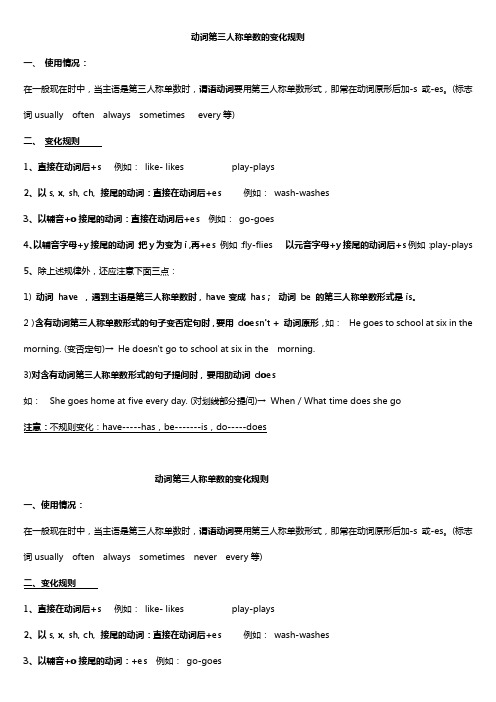
动词第三人称单数的变化规则一、使用情况:在一般现在时中,当主语是第三人称单数时,谓语动词要用第三人称单数形式,即常在动词原形后加-s或-es。
(标志词usually often always sometimes every等)二、变化规则1、直接在动词后+s 例如:like- likes play-plays2、以s, x, sh, ch, 接尾的动词:直接在动词后+es 例如:wash-washes3、以辅音+o接尾的动词:直接在动词后+es 例如:go-goes4、以辅音字母+y接尾的动词:把y为变为i,再+es 例如:fly-flies 以元音字母+y接尾的动词后+s例如:play-plays5、除上述规律外,还应注意下面三点:1)动词have ,遇到主语是第三人称单数时,have变成has;动词be 的第三人称单数形式是is。
2)含有动词第三人称单数形式的句子变否定句时,要用doesn't + 动词原形,如:He goes to school at six in the morning. (变否定句)→He doesn't go to school at six in the morning.3)对含有动词第三人称单数形式的句子提问时,要用助动词does如:She goes home at five every day. (对划线部分提问)→When / What time does she go注意:不规则变化:have-----has,be-------is,do-----does动词第三人称单数的变化规则一、使用情况:在一般现在时中,当主语是第三人称单数时,谓语动词要用第三人称单数形式,即常在动词原形后加-s或-es。
(标志词usually often always sometimes never every等)二、变化规则1、直接在动词后+s 例如:like- likes play-plays2、以s, x, sh, ch, 接尾的动词:直接在动词后+es 例如:wash-washes3、以辅音+o接尾的动词:+es 例如:go-goes4、以辅音字母+y接尾的动词:把y变为i,再+es 例如:fly-flies 以元音字母+y接尾的动词后+s例如:play-plays5、除上述规律外,还应注意下面三点:1)动词have ,遇到主语是第三人称单数时,have变成has;动词be 的第三人称单数形式是is。
一般现在时单三形式练习题

一般现在时单三形式练习题一般现在时是英语中最基础也最常用的时态之一。
它用来描述现在正在发生的事情、现实存在的事情、经常发生的事情以及普遍真理等。
在一般现在时中,动词的单数第三人称形式需要在动词末尾加上-s或-es。
以下是一些练习题,每个句子中都需要用到动词的单数第三人称形式:1. My cat usually __________ (sleep) on the windowsill in the afternoon.2. Alice __________ (speak) three languages fluently.3. The sun __________ (rise) in the east.4. He __________ (work) as a teacher at the local school.5. This plant __________ (require) a lot of sunlight to grow.6. The dog __________ (bark) loudly whenever someone knocks on the door.7. She always __________ (arrive) at work on time.8. The Earth __________ (rotate) on its axis once every 24 hours.9. John __________ (enjoy) playing basketball in his free time.10. It __________ (take) her 30 minutes to get to work every morning.参考答案:1. My cat usually sleeps on the windowsill in the afternoon.2. Alice speaks three languages fluently.3. The sun rises in the east.4. He works as a teacher at the local school.5. This plant requires a lot of sunlight to grow.6. The dog barks loudly whenever someone knocks on the door.7. She always arrives at work on time.8. The Earth rotates on its axis once every 24 hours.9. John enjoys playing basketball in his free time.10. It takes her 30 minutes to get to work every morning.在以上练习题中,动词的单数第三人称形式已经正确使用。
(完整版)第三人称单数专项练习
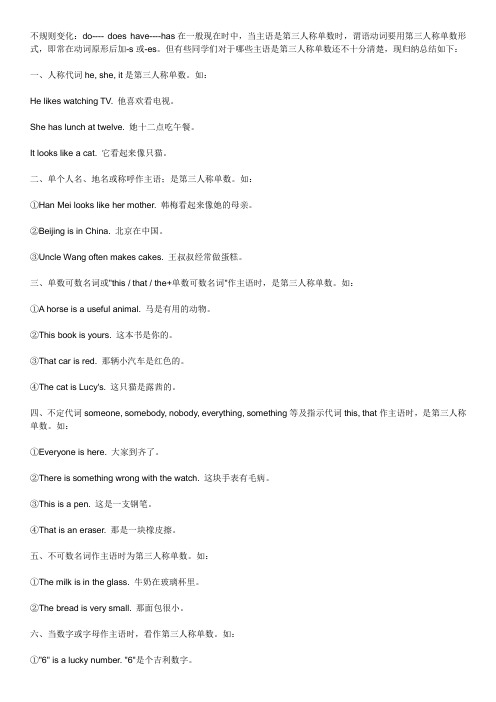
不规则变化:do---- does have----has在一般现在时中,当主语是第三人称单数时,谓语动词要用第三人称单数形式,即常在动词原形后加-s或-es。
但有些同学们对于哪些主语是第三人称单数还不十分清楚,现归纳总结如下:一、人称代词he, she, it是第三人称单数。
如:He likes watching TV. 他喜欢看电视。
She has lunch at twelve. 她十二点吃午餐。
It looks like a cat. 它看起来像只猫。
二、单个人名、地名或称呼作主语;是第三人称单数。
如:①Han Mei looks like her mother. 韩梅看起来像她的母亲。
②Beijing is in China. 北京在中国。
③Uncle Wang often makes cakes. 王叔叔经常做蛋糕。
三、单数可数名词或"this / that / the+单数可数名词"作主语时,是第三人称单数。
如:①A horse is a useful animal. 马是有用的动物。
②This book is yours. 这本书是你的。
③That car is red. 那辆小汽车是红色的。
④The cat is Lucy's. 这只猫是露茜的。
四、不定代词someone, somebody, nobody, everything, something等及指示代词this, that作主语时,是第三人称单数。
如:①Everyone is here. 大家到齐了。
②There is something wrong with the watch. 这块手表有毛病。
③This is a pen. 这是一支钢笔。
④That is an eraser. 那是一块橡皮擦。
五、不可数名词作主语时为第三人称单数。
如:①The milk is in the glass. 牛奶在玻璃杯里。
一般现在时动词三单练习

一般现在时动词三单练习动词第三人称单数形式的练:drink - drinksgo - goesstay - XXXmake - XXXlook - lookshave - haspass - passescarry - carriescome - comeswatch - watchesplant - plantsfly - fliesstudy - studiesXXX - XXXXXX - XXXwash - washesmatch - matchesguess - guessesfinish - finishes二.用括号内动词的适当形式填空。
1.He often has dinner at home.2.We do not watch TV on Monday.3.Nick does not go to the zoo on Sunday.4.Do they like the World Cup?5.What do they often do on Saturdays?6.Do your parents read newspapers every day?7.XXX.8.She and I take a walk XXX.9.There is some water in the bottle.10.XXX XXX cooking.11.They have the same hobby.12.XXX.13.You always do your homework well.14.I am XXX I'm staying in bed.15.XXX.16.Liu Tao does not like PE.17.The child often watches TV in the evening.18.Su Hai and Su Yang have eight lessons this term.19.I like swimming.20.He reads English every day.21.We go to school at seven in the morning.22.Mike goes to school at seven in the morning.23.XXX to go shopping.24.I can draw many beautiful pictures.25.She makes a model plane.26.Do you like to run?27.Does he like to jump?28.Does XXX Saturday?29.XXX XXX dance.30.XXX dance.31.The students speak English in class.32.The student speaks Chinese after class.33.Let's go and play football.XXX swimming.35.I'm XXX.36.Do you study English at school。
一般现在时的用法及练习题(带答案)
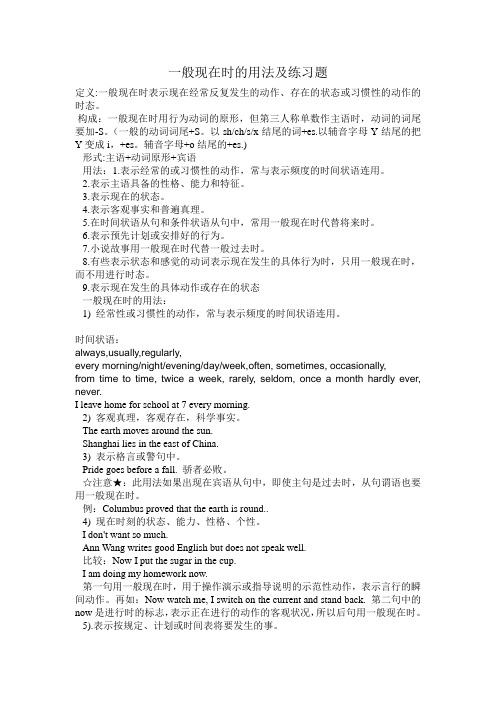
一般现在时的用法及练习题定义:一般现在时表示现在经常反复发生的动作、存在的状态或习惯性的动作的时态。
构成:一般现在时用行为动词的原形,但第三人称单数作主语时,动词的词尾要加-S。
(一般的动词词尾+S。
以sh/ch/s/x结尾的词+es.以辅音字母Y结尾的把Y变成i,+es。
辅音字母+o结尾的+es.)形式:主语+动词原形+宾语用法:1.表示经常的或习惯性的动作,常与表示频度的时间状语连用。
2.表示主语具备的性格、能力和特征。
3.表示现在的状态。
4.表示客观事实和普遍真理。
5.在时间状语从句和条件状语从句中,常用一般现在时代替将来时。
6.表示预先计划或安排好的行为。
7.小说故事用一般现在时代替一般过去时。
8.有些表示状态和感觉的动词表示现在发生的具体行为时,只用一般现在时,而不用进行时态。
9.表示现在发生的具体动作或存在的状态一般现在时的用法:1) 经常性或习惯性的动作,常与表示频度的时间状语连用。
时间状语:always,usually,regularly,every morning/night/evening/day/week,often, sometimes, occasionally,from time to time, twice a week, rarely, seldom, once a month hardly ever, never.I leave home for school at 7 every morning.2) 客观真理,客观存在,科学事实。
The earth moves around the sun.Shanghai lies in the east of China.3) 表示格言或警句中。
Pride goes before a fall. 骄者必败。
☆注意★:此用法如果出现在宾语从句中,即使主句是过去时,从句谓语也要用一般现在时。
例:Columbus proved that the earth is round..4) 现在时刻的状态、能力、性格、个性。
一般现在时(第三人称单数形式_)及练习
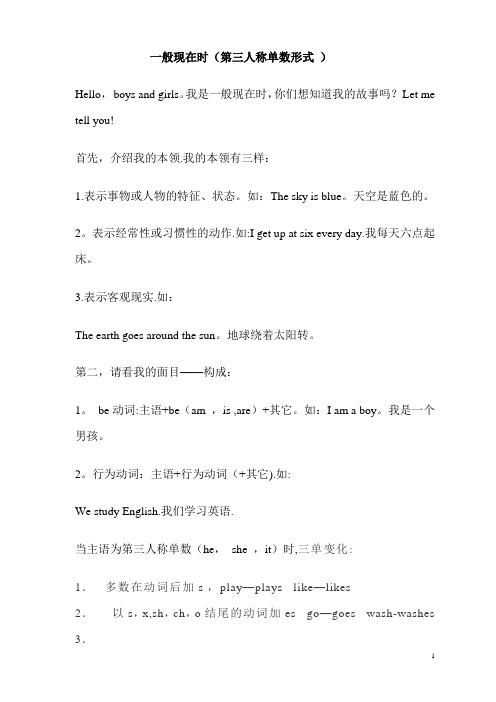
一般现在时(第三人称单数形式)Hello,boys and girls。
我是一般现在时,你们想知道我的故事吗?Let me tell you!首先,介绍我的本领.我的本领有三样:1.表示事物或人物的特征、状态。
如:The sky is blue。
天空是蓝色的。
2。
表示经常性或习惯性的动作.如:I get up at six every day.我每天六点起床。
3.表示客观现实.如:The earth goes around the sun。
地球绕着太阳转。
第二,请看我的面目——构成:1。
be动词:主语+be(am ,is ,are)+其它。
如:I am a boy。
我是一个男孩。
2。
行为动词:主语+行为动词(+其它).如:We study English.我们学习英语.当主语为第三人称单数(he,she ,it)时,三单变化:1.多数在动词后加s ,play—plays like—likes2.以s,x,sh,ch,o结尾的动词加es go—goes wash-washes 3.4.以辅音字母加y结尾,把y改i再加es,fly—flies 。
元音字母加y结尾的,直接加s,play—plays.5.特殊:have—has第三,我的变化——否定句、一般疑问句、特殊疑问句:1.be动词的变化。
否定句:主语+ be + not +其它。
如:He is not a worker。
他不是工人。
一般疑问句:Be +主语+其它。
如:-Are you a student?—Yes。
I am。
/ No, I'm not。
特殊疑问句:疑问词+一般疑问句.如:Where is my bike?2.行为动词的变化。
否定句:主语+ don’t(doesn’t ) +动词原形(+其它)。
如:I don't like bread。
当主语为第三人称单数时,要用doesn't构成否定句.如:He doesn't often play.一般疑问句:Do(Does ) +主语+动词原形+其它。
一般现在时主语三单的动词变化与练习
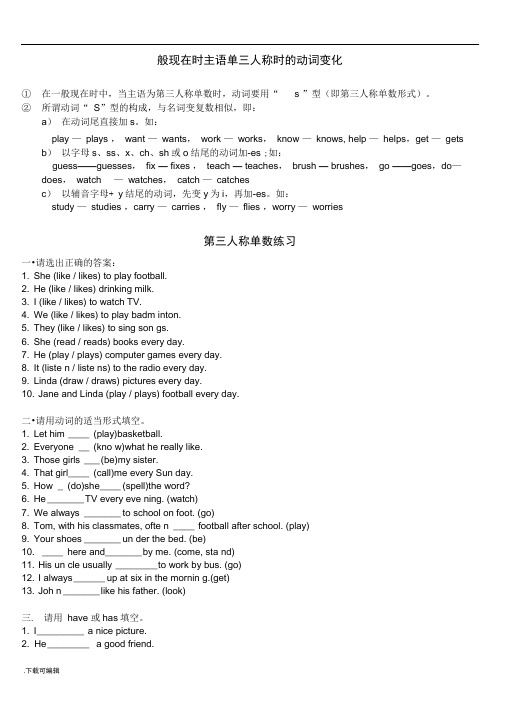
般现在时主语单三人称时的动词变化①在一般现在时中,当主语为第三人称单数时,动词要用“s ”型(即第三人称单数形式)。
②所谓动词“ S”型的构成,与名词变复数相似,即:a)在动词尾直接加s。
如:play —plays ,want —wants,work —works,know —knows, help —helps,get —gets b)以字母s、ss、x、ch、sh或o结尾的动词加-es ;如:guess——guesses,fix — fixes ,teach — teaches,brush — brushes,go ——goes,do—does,watch —watches,catch —catchesc)以辅音字母+ y结尾的动词,先变y为i,再加-es。
如:study —studies ,carry —carries ,fly —flies ,worry —worries第三人称单数练习一•请选出正确的答案:1. She (like / likes) to play football.2. He (like / likes) drinking milk.3. I (like / likes) to watch TV.4. We (like / likes) to play badm inton.5. They (like / likes) to sing son gs.6. She (read / reads) books every day.7. He (play / plays) computer games every day.8. It (liste n / liste ns) to the radio every day.9. Linda (draw / draws) pictures every day.10. Jane and Linda (play / plays) football every day.二•请用动词的适当形式填空。
初一英语一般现在时第三人称单数变化规则单选题30题
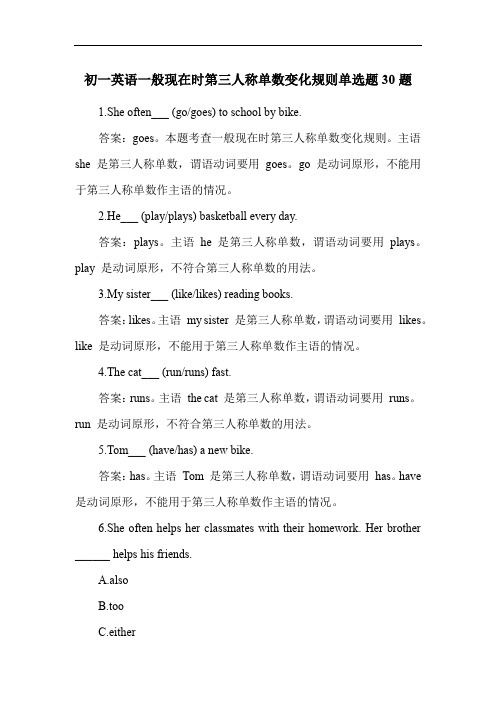
初一英语一般现在时第三人称单数变化规则单选题30题1.She often___ (go/goes) to school by bike.答案:goes。
本题考查一般现在时第三人称单数变化规则。
主语she 是第三人称单数,谓语动词要用goes。
go 是动词原形,不能用于第三人称单数作主语的情况。
2.He___ (play/plays) basketball every day.答案:plays。
主语he 是第三人称单数,谓语动词要用plays。
play 是动词原形,不符合第三人称单数的用法。
3.My sister___ (like/likes) reading books.答案:likes。
主语my sister 是第三人称单数,谓语动词要用likes。
like 是动词原形,不能用于第三人称单数作主语的情况。
4.The cat___ (run/runs) fast.答案:runs。
主语the cat 是第三人称单数,谓语动词要用runs。
run 是动词原形,不符合第三人称单数的用法。
5.Tom___ (have/has) a new bike.答案:has。
主语Tom 是第三人称单数,谓语动词要用has。
have 是动词原形,不能用于第三人称单数作主语的情况。
6.She often helps her classmates with their homework. Her brother ______ helps his friends.A.alsoB.tooC.either答案:A。
本题考查“也”的用法。
“also”一般放在句中,“too”一般放在句末,用逗号隔开,“either”用于否定句,“neither”表示两者都不。
此句是肯定句且需要放在句中,所以选“also”。
一般现在时中,当主语是第三人称单数时,动词要用第三人称单数形式,这里“Her brother”是第三人称单数,“helps”是第三人称单数形式,符合一般现在时第三人称单数变化规则。
第三人称单数专项练习(动词)

不规则变化:do---- does have----has在一般现在时中,当主语是第三人称单数时,谓语动词要用第三人称单数形式,即常在动词原形后加-s或-es。
但有些同学们对于哪些主语是第三人称单数还不十分清楚,现归纳总结如下:一、人称代词he, she, it是第三人称单数。
如:1.He likes watching TV. 他喜欢看电视。
2.She has lunch at twelve. 她十二点吃午餐。
3.It looks like a cat. 它看起来像只猫。
二、单个人名、地名或称呼作主语;是第三人称单数。
如:1.Han Mei looks like her mother. 韩梅看起来像她的母亲。
2.Beijing is in China. 北京在中国。
3.Uncle Wang often makes cakes. 王叔叔经常做蛋糕。
三、单数可数名词或"this / that / the+单数可数名词"作主语时,是第三人称单数。
如:1.A horse is a useful animal. 马是有用的动物。
2.This book is yours. 这本书是你的。
3.That car is red. 那辆小汽车是红色的。
4.The cat is Lucy's. 这只猫是露茜的。
四、不定代词someone, somebody, nobody, everything, something等及指示代词this, that作主语时,是第三人称单数。
如:1.Everyone is here. 大家到齐了。
2.There is something wrong with the watch. 这块手表有毛病。
3.This is a pen. 这是一支钢笔。
4.That is an eraser. 那是一块橡皮擦。
五、不可数名词作主语时为第三人称单数。
如:1.The milk is in the glass. 牛奶在玻璃杯里。
小学动词第三人称单数形式用法+练习

小学动词第三人称单数形式用法+练习一般现在时中的第三人称单数形式一般现在时用于表示事物或人物的特征、状态、经常性或惯性的动作,以及客观现实。
当主语为第三人称单数时,谓语动词应使用第三人称单数形式,即在动词原形后加-s或-es。
一般现在时的基本用法一般现在时有以下基本用法:1.表示事物或人物的特征、状态,如“天空是蓝色的”;2.表示经常性或惯性的动作,如“我每天六点起床”;3.表示客观现实,如“地球绕着太阳转”。
标志词(时间状语)包括always。
every week (day。
year。
month…)。
once a week。
every…。
sometimes。
at…。
on Sunday。
usually。
often。
never。
hardly等。
哪些主语是第三人称单数?以下主语是第三人称单数:1.人称代词he。
she。
it,如“他喜欢看电视”;2.单个人名、地名或称呼作主语,如“XXX看起来像她的母亲”;3.单数可数名词或“this / that / the+单数可数名词”作主语时,如“马是有用的动物”;4.不定代词someone。
somebody。
nobody。
everything。
something等及指示代词this。
that作主语时,如“大家到齐了”。
1.This is a pen。
(改写) This object is a XXX.2.That is an eraser。
(改写) The object over there is a rubber eraser.3.The milk is in the glass。
(改写) The glass contains milk.4.The bread is very small。
(改写) The size of the bread isvery small.5."6" is a lucky number。
(改写) The number "6" is XXX.6."I" XXX(改写) The character "I" is a letter.7.大多数动词在词尾加“S”。
(完整版)第三人称单数专项练习

不规则变化:do---- does have----has在一般现在时中,当主语是第三人称单数时,谓语动词要用第三人称单数形式,即常在动词原形后加-s或-es。
但有些同学们对于哪些主语是第三人称单数还不十分清楚,现归纳总结如下:一、人称代词he, she, it是第三人称单数。
如:He likes watching TV. 他喜欢看电视。
She has lunch at twelve. 她十二点吃午餐。
It looks like a cat. 它看起来像只猫。
二、单个人名、地名或称呼作主语;是第三人称单数。
如:①Han Mei looks like her mother. 韩梅看起来像她的母亲。
②Beijing is in China. 北京在中国。
③Uncle Wang often makes cakes. 王叔叔经常做蛋糕。
三、单数可数名词或"this / that / the+单数可数名词"作主语时,是第三人称单数。
如:①A horse is a useful animal. 马是有用的动物。
②This book is yours. 这本书是你的。
③That car is red. 那辆小汽车是红色的。
④The cat is Lucy's. 这只猫是露茜的。
四、不定代词someone, somebody, nobody, everything, something等及指示代词this, that作主语时,是第三人称单数。
如:①Everyone is here. 大家到齐了。
②There is something wrong with the watch. 这块手表有毛病。
③This is a pen. 这是一支钢笔。
④That is an eraser. 那是一块橡皮擦。
五、不可数名词作主语时为第三人称单数。
如:①The milk is in the glass. 牛奶在玻璃杯里。
一般现在时第三人称单数形式用法+练习

一般现在时第三人称单数形式用法+练习(总3页)一般现在时中的第三人称单数形式在一般现在时中,当主语是第三人称单数时,谓语动词要用第三人称单数形式,即常在动词原形后加-s或-es。
(-)什么是一般现在时一般现在时的基本用法有哪些呢?【一般现在时的功能】1 •表示事物或人物的特征、状态。
如:The sky is blue.天空是蓝色的。
2.表示经常性或习惯性的动作。
如:I get up at six every day.我每天六点起床。
Z X标志词(时间状语): a I ways, every week (day, year. I mon th …).once a week, every…,sometimes t at…,on Sunday3•表示客观现实。
如:The earth goes around the sun•地球绕着太阳转。
(-)哪些主语是第三人称单数现归纳总结如下:一、人称代词he, she, it是第三人称单数。
如:He I ikes watching TV.他喜欢看电视。
She has lunch at twe I ve.她十二点吃午餐。
It looks I ike a cat.它看起来像只猫。
二、单个人名、地名或称呼作主语;是第三人称单数。
如:①Tom looks I ike her mother.韩梅看起来像她的母亲。
②Beijing is in China・北京在中国。
③Uncle Wang often makes cakes.王叔叔经常做蛋糕。
三、单数可数名词或壮his / that / the+单数可数名词11作主语时.是第三人称单。
如:®A horse is a useful animal・马是有用的动物。
②Th is book i s yours.这本书是你的。
③That car is red.那辆小汽车是红色的。
④The cat i s Lucy* s.这只猫是露茜的。
- 1、下载文档前请自行甄别文档内容的完整性,平台不提供额外的编辑、内容补充、找答案等附加服务。
- 2、"仅部分预览"的文档,不可在线预览部分如存在完整性等问题,可反馈申请退款(可完整预览的文档不适用该条件!)。
- 3、如文档侵犯您的权益,请联系客服反馈,我们会尽快为您处理(人工客服工作时间:9:00-18:30)。
一般现在时中的第三人称单数形式
在一般现在时中,当主语是第三人称单数时,谓语动词要用第三人称单数形式,即常在动词原形后加-s或-es。
(一)什么是一般现在时一般现在时的基本用法有哪些呢
【一般现在时的功能】
1.表示事物或人物的特征、状态。
如:The sky is blue.天空是蓝色的。
2.表示经常性或习惯性的动作。
如:I get up at six every day.我每天六点起床。
3.表示客观现实。
如:The earth goes around the sun.地球绕着太阳转。
(二)哪些主语是第三人称单数现归纳总结如下:
一、人称代词he, she, it是第三人称单数。
如:
He likes watching TV. 他喜欢看电视。
She has lunch at twelve. 她十二点吃午餐。
It looks like a cat. 它看起来像只猫。
二、单个人名、地名或称呼作主语;是第三人称单数。
如:
①Tom looks like her mother. 韩梅看起来像她的母亲。
②Beijing is in China. 北京在中国。
③Uncle Wang often makes cakes. 王叔叔经常做蛋糕。
三、单数可数名词或"this / that / the+单数可数名词"作主语时,是第三人称单。
如:
①A horse is a useful animal. 马是有用的动物。
②This book is yours. 这本书是你的。
③That car is red. 那辆小汽车是红色的。
④The cat is Lucy's. 这只猫是露茜的。
四、不定代词someone, somebody, nobody, everything, something等及指示代词this, that作主语时,是第三人称单数。
如:
①Everyone is here. 大家到齐了。
②There is something wrong with the watch. 这块手表有毛病。
③This is a pen. 这是一支钢笔。
④That is an eraser. 那是一块橡皮擦。
五、不可数名词作主语时为第三人称单数。
如:
①The milk is in the glass. 牛奶在玻璃杯里。
②The bread is very small. 那面包很小。
六、当数字或字母作主语时,看作第三人称单数。
如:
①"6" is a lucky number. "6"是个吉利数字。
②"I" is a letter. "I"是个字母。
PS:除上述规律外,还应注意下面三点:
1. 动词have ,遇到主语是第三人称单数时,要用has;动词be 的第三人称单数形式是is。
2. 含有动词第三人称单数形式的句子变否定句时,要用doesn't + 动词原形,如:He goes to school at six in the morning. (变否定句)→
He doesn't go to school at six in the morning.
3. 对含有动词第三人称单数形式的句子提问时,要用助动词does,如:
She goes home at five every day. (对划线部分提问)→
When / What time does she go home every day
(三)一般现在时------动词第三人称单数形式构成规则(一般现在时中主语时第三人称
1、大多数动词在词尾加“S”如:
①stop-stops make-makes read-reads play-plays
2、以辅音字母加“y”结尾的,要先将“y”变为“i”,然后在加“es”;以元音字母加“y”结尾的,直接加“S”如:
fly-flies carry-carries study-studies worry-worries
3、以“s, x, ch, sh”结尾的,在词尾加“es”,发音为如:
teach-teaches watch-watches
4、以“o”结尾的动词,加“es”,如:
go-goes do-does
5、以不发音字母“e”结尾的开音节词,加“s”如:close-closes [iz]
6、特殊:
○1. be动词包括:am,is,are。
第三人称单数用is;过去式为was;复数用are,过去式为were.
○2. 动词have ,遇到主语是第三人称单数时,要用has;动词be 的第三人称单数形式is。
(四)巩固练习题:
一、写出下列动词的第三人称单数形式:
sit-- guess-- die-- go--
rush-- reach-- touch-- brush--
fly-- copy-- say-- run--
do-- fix-- live-- cry--
enjoy-- have-- wish-- play--
tie-- teach-- buy-- study--
drink-- go-- stay-- make--
look-- carry-- come-- watch--
plant-- fly -- do--
二、用括号内动词的适当形式填空。
1. He often ________(have) dinner at home.
2. Daniel and Tommy _______(be) in Class One.
3. We _______(not watch) TV on Monday.
4. Nick _______(not go) to the zoo on Sunday.
5. ______ they ________(like) the World Cup
6. What _______they often _______(do) on Saturdays
7. _______ your parents _______(read) newspapers every day
8. The girl _______(teach) us English on Sundays.
9. She and I ________(take) a walk together every evening.
10. There ________(be) some water in the bottle.
11. Mike _______(like) cooking.
12. They _______(have) the same hobby.
13. My aunt _______(look) after her baby carefully.
14. You always _______(do) your homework well.
15. I _______(be) ill. I’m staying in bed.
16. She _______(go) to school from Monday to Friday.
17. Liu Tao _______(do) not like PE.
18. The child often _______(watch) TV in the evening.
19. Su Hai and Su Yang _______(have) eight lessons this term.
20. -What day _______(be) it today
-It’s Saturday
三、观察下面两组句子,注意区分do和does,don’t和doesn’t。
I go to school every day. I don't go to school every day.
He goes to school every day. He doesn't go to school every day.
Do you go to school every day Yes, I do. (No, I don't)
Does he go to school every day Yes, he does. (No, he doesn't)
注:
(1)肯定句变否定句,第三人称单数把does变doesn’t (does not),其余把do变don’t(do not),后面跟动词原形.(一请一还原)
(2)变为一般疑问句,要在句首加"do" 或does ,这取决于主语是否第三人称单数。
课堂练习:把下列句子改成一般疑问句和否定句。
1.I usually get up at six o’clock.(并作肯定回答)
2. We usually write e-mails on Saturday evening.(并作否定回答)
.
3. They have the same hobby.(并作肯定回答)
.
and Su yang like listening to music after school.(并作否定回答)
usually watches TV in the evening.(并作肯定回答)。
